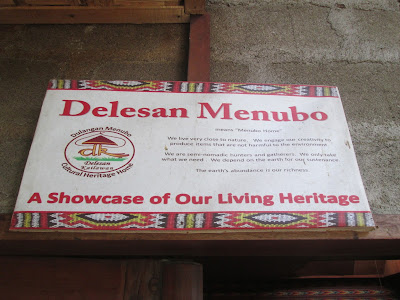which has facilities for Dulangan Manobos.
I had been wishing Kulaman Plateau had something like a museum—a place that exhibits the traditional objects that the Dulangan Manobo people use. I was therefore delighted when I found out that such a place exists. It’s run not by the local government, as the case should ideally be, but by missionary Catholic nuns. It’s a little disappointing—though not wholly unexpected—to find out that religious and civic organizations still do more for indigenous people than the government does.
The Sisters of Our Lady of the Missions (RNDM) call the place Delesan Kailawan, which means “cultural heritage home.” It is situated beside Notre Dame of Kulaman, a school that offers basic education and run by the diocese. The Catholic Church and the priests’ compound are on the other side of the school. Delesan Kailawan is really a convent with added facilities for the Dulangan Manobo, especially women, who avail themselves of the scholarship grants, medical assistance, livelihood trainings, and other programs offered by the RNDM sisters. Sister Kikiwin and Sister Weeyyaa told me a few things about the work of their congregation, but I ought to go back there and ask them more about that. When I visited Delesan Kailawan, twice, I was pressed for time and I was too excited to see the Manobo objects and identify them.
The compound is indeed a home. Well-maintained gardens surround the structures. When you enter the gates, a paved footpath leads you to Tegasalibatun, a two-story “place of welcome.” The nuns who welcomed my companions and me came out of the building, so I assume it is where the nuns and their scholars stay. Beside Tegasalibatun is a one-room structure, which must be a chapel. Retrace your steps, but instead of going back to the gates, walk to a structure that looks like a classroom. It is partially hidden from the gates because the ground it is built on is slightly sunken. The room is Delesan Menubo, which literally means “Menubo home.” It is where the tribal objects are found. It was my main destination. I spent a long time inside it during my visits, taking photos and identifying the displayed objects (which have not been labeled yet) with the help of the Manobo scholars who were around.
Attached to Delesan Menubo is a large shed made of wood and kalakat (weaved African palm). It’s Keseteponoy, which means “gathering.” It’s where meetings, trainings, and related activities are conducted. During my visits, I noticed a few Manobo women and their children coming from the direction of Keseteponoy and peeking at me and the Manobo girls in the Delesan Menubo, curious about what we were doing there. The Manobo girls told me that the women and children were patients. One toddler had two deep gashes on her head which probably started as mere itchy spots. There was apparently a clinic inside the compound. But I didn’t see the clinic. All I can share with you now are photos of Tegasalibatun, Delesan Menubo, and Keseteponoy. As to the traditional Manobo objects, I’ll share their photos with you next year, a few months from now, after I’ve checked and rechecked their names.
Tegasalibatun, where the RNDM sisters and their female Manobo scholars stay
A chapel beside Tegasalibatun
Delesan Menubo, the room where Manobo items are on display
The Manobo girsl who helped me identify the objects in Delesan Menubo.
As I read the items in my prepared list, they pointed the samples to me.
Keseteponoy, where trainings and meetings are held









No comments:
Post a Comment